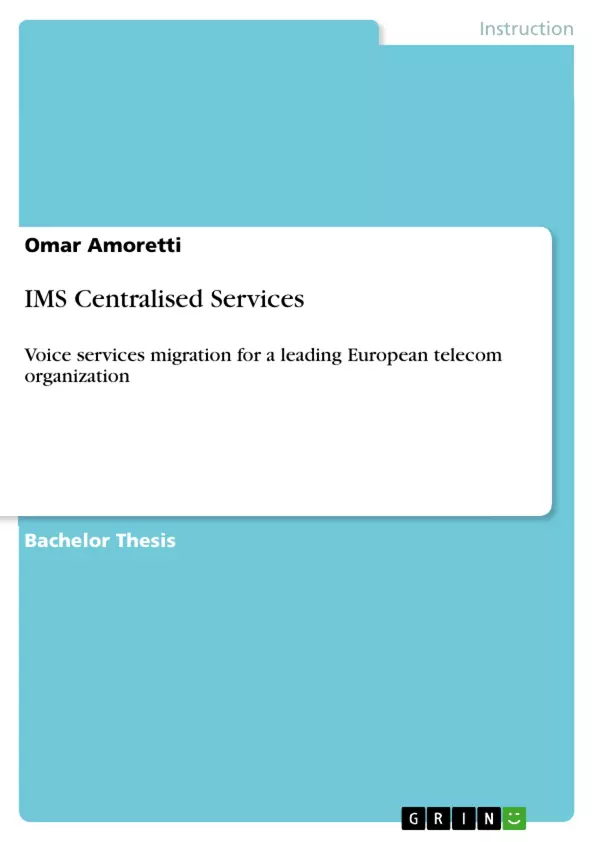This bachelor thesis aims at providing an overview of the evolution process from the current circuit-switched (CS) voice services to those based on the IP multimedia subsystem (IMS). The timeline in question comprises the years 2013 to 2018 and takes into consideration three possible scenarios: one intermediate state and two target states, each of them presenting a particular setting in respect to the CS & IP domain mediation.
Those states are subsequently evaluated according to certain predefined criteria. In addition, a complementary framework is given by the SWOT analysis which will consequently lead to the final recommendations for one of the leading European telecom organizations (the company in question is not disclosed throughout this thesis on purpose). Within this context, the major characteristics of the Austrian as well as European mobile markets are examined. Finally, the expected key assumptions and developments for the given timeframe are presented together with the particular findings of the topics previously described.
As a starting point, the basic IMS architecture is presented together with its major features in respect to other current technologies. In a further step and based on the previous information, the key motivations for the transition from CS to IMS-based voice services will be discussed. In this sense, a service consistency delivered by centralized services on an access agnostic basis is assumed.
For this purpose the initial state is evaluated regarding its three relevant levels: the transport/endpoint, session/control and application/service layers. Next, a more comprehensive approach, the intermediate state, is evaluated: here, the legacy SCP supports the CS&IP domain mediation via the IM-SSF. Moreover, two other target states are assessed involving the SIP AS using a reverse IM-SSF and the L2 interface respectively.
Having highlighted the significant characteristics of each (future) state, attention is then drawn on the various criteria for IMS-based voice services such as roaming, handset capabilities and the like. Hence, a SWOT analysis is presented addressing the question ‘Is the deployment of the intermediate state from a technical and economic perspective recommendable? Finally, the major mobile market characteristics in Europe as well as the expected developments for the timeframe 2013 - 2018 will be described. Furthermore, the concluding recommendations are derived from the key findings throughout this thesis.
Inhaltsverzeichnis (Table of Contents)
- Introduction
- Thesis structure
- Motivations behind IMS.
- Motivations from the operator's perspective.
- Motivations from the user's perspective........
- Overview of the IMS architecture ....
- Drivers...........
- IMS horizontal architecture
- Evolution 2G/3G to IMS
- 2G/3G technology features.
- Towards IMS .......
- Intelligent Network (IN) limitations
- From circuit-switched to IMS-based voice services
- Development path 2013 - 2018
- Initial state..
- Intermediate state based on SCP and IM-SSF..
- Service delivery platform and the Service Broker.
- Service Broker benefits.
- Intermediate state setting.....
- Target state 1 based on the SIP AS and rIM-SSF
- Target state 2 based on the SIP AS and the 12 interface...........
- Analysis criteria for IMS-based Voice services
- LTE coverage...
- Handset capabilities ......
- Service consistency.
- Roaming.......
- Standardisation
- SWOT analysis .....
- Refarming and the Digital Dividend
- Further considerations ...
- Major mobile market characteristics
- Consolidation trends
- Regulation and competition
Zielsetzung und Themenschwerpunkte (Objectives and Key Themes)
This bachelor thesis explores the evolution of voice services from the traditional circuit-switched (CS) technology to the IP multimedia subsystem (IMS), focusing on the period between 2013 and 2018. The study analyzes three potential scenarios: an intermediate state and two target states, each with a distinct approach to CS & IP domain mediation.
- Transition from CS to IMS-based voice services.
- Comparison of different IMS evolution scenarios.
- Assessment of IMS-based voice services based on specific criteria.
- SWOT analysis of IMS deployment.
- Analysis of the European mobile market landscape.
Zusammenfassung der Kapitel (Chapter Summaries)
The thesis begins by introducing the concept of IMS, outlining its architectural structure and advantages over existing technologies. The first chapter also details the motivations behind the transition from CS to IMS-based voice services, both from the operator's and the user's perspective.
Chapter 2 provides an overview of the IMS architecture, highlighting its key features and drivers. Subsequently, Chapter 3 explores the evolution from 2G/3G to IMS, analyzing the technology features of earlier generations and the limitations of the Intelligent Network (IN).
Chapter 4 dives deeper into the transition from circuit-switched to IMS-based voice services. The chapter outlines a detailed development path from 2013 to 2018, examining three potential scenarios: an initial state, an intermediate state, and two target states. These scenarios are evaluated based on various criteria, including LTE coverage, handset capabilities, service consistency, roaming, and standardization. The chapter concludes with a SWOT analysis, assessing the feasibility of implementing the intermediate state from a technical and economic perspective.
Chapter 5 delves into the broader context of the European mobile market, analyzing its major characteristics, including consolidation trends and regulatory aspects. This chapter provides a foundation for understanding the market forces influencing the deployment of IMS-based voice services.
Schlüsselwörter (Keywords)
The primary focus of this thesis lies on the IP Multimedia Subsystem (IMS), specifically its centralized services and the evolution path for voice services from 2013 to 2018. Key concepts include circuit-switched (CS) technology, domain mediation, service consistency, standardization, roaming, SWOT analysis, and the European mobile market landscape.
- Quote paper
- MSc. Omar Amoretti (Author), 2013, IMS Centralised Services, Munich, GRIN Verlag, https://www.grin.com/document/454992



